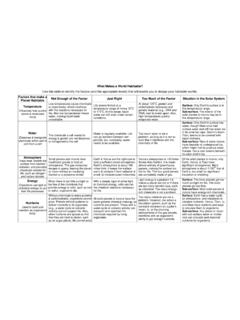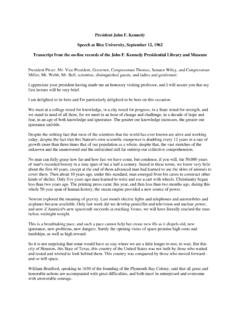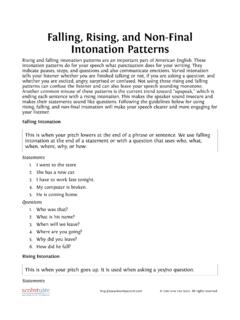Transcription of Communication Patterns and Assumptions
1 Communication Patterns and Assumptions of Differing Cultural Groups in the United States Comparisons of cultural value systems are not meant to stereotype individuals or cultures; rather, they are meant to provide generalizations, observations about a group of people, from which we can discuss cultural difference and likely areas of miscommunication. Adapted from Elliott, C. E. (1999) Cross-Cultural Communication Styles, pre-publication Masters thesis Online at African American Communication Patterns According to the Centers for Disease Control and Prevention (1999), African Americans comprise 13 percent of the population. Animation/emotion: Communication seen as authentic is generally passionate and animated.
2 Communication that is presented in a neutral or objective way is seen as less credible, and the motives of the speaker may be questioned. The assumption is that if you believe something, you will advocate for it. Truth is established through argument and debate. "Conversational style is provocative and challenging, and the intensity is focused on the validity of the ideas being discussed" (Kochman 1981 pp. 30-31). Effective teachers of African American students are often found "..displaying emotion to garner student respect" (Delpit, 1995, p. 142). African Americans tend to perceive greater emotional intensity when rating the expressions of others (Matsumoto, 1993). Directness/indirectness: Generally directly facing and talking with the person with whom you have an issue or problem is preferred.
3 Someone who won t face you directly shows his or her claim or problem to be invalid; the assumption is that anyone with a legitimate problem would come to the other person directly. A lack of response to a general accusation or allegation by someone is viewed as an indication of innocence. The internal attitude of an innocent person is "I know they aren t talking about me, so I don t have to respond."(Kochman 1981 ). Responding to a general accusation shows that the "mark hit home." A direct accusation will usually bring a direct denial and a request to confront the person making the allegation. In terms of romance, men and often women will usually state directly whether they are interested in a potential relationship.
4 Ignoring or acting subtly disinterested is not interpreted as a sign of disinterest from a woman; it may be seen as a rude or arrogant response (Kochman 1981). Teachers are often expected to show they care by "..controlling the class; exhibiting personal power; establishing meaningful personal relationships;.. pushing students to achieve the (class) standard; and holding the attention of the students by incorporating African-American interactional styles in their teaching" (Delpit, 1995, p. 142). Eye contact: Tends to be quite direct and prolonged when speaking, less so when listening. This is the opposite of the dominant-culture pattern in which the speaker tends to look away from the listener and the listener looks directly at the speaker.
5 The overall amount of eye contact is not different from dominant-culture Patterns ; it is when the eye contact occurs that differs (Johnson, 1971, p. 17). Gestures: Frequent and sometimes large gestures are normative. The expressiveness of the Communication is what is valued, and if the gestures increase expressiveness they are seen as enhancing Communication . (V. Valdez, September 1998, personal Communication ). Identity orientation: Traditionally, African Americans have a more collateral orientation than European Americans (Nichols 1986, management training session). Self is viewed and decisions are made within the context of the group and by assessing how the action will affect others in the collateral identity group.
6 Turn taking and pause time: Turns are taken when the speaker is moved to speak; urgency, status, and the ability to command attention from others determines speaking order. The right to continue speaking is granted by others depending on how well the speaker s idea is being accepted (Kochman 1981 pp. 34). Responses from others are usually made at the end of each of the speaker s points, and this is not felt to be an interruption of the speaker (Kochman 1981 ). Turn taking in dyads is also regulated by non-verbal cues that differ markedly from those of the dominant culture. These include: hand gestures, postural shifts which mirror the conversational partner, intonation drop, tempo slowing, and lessening of intensity.
7 The change in gaze direction employed in the dominant culture is often not used (LaFrance & Mayo, 1975, pp. 7-8). Pause time is often brief; people in groups may interrupt or speak on the ends of other s sentences. Space: Research on use of space among African Americans is mixed. Some studies indicate that, in race-matched pairs, black children will stand closer to each other during conversation than white children do. Other research has shown that African American adults employ a greater public distance from each other (LaFrance & Mayo, 1978, pp. 79-80). Time: Linear time is not internalized to the extent it is in the dominant society. Being a more relationship-oriented culture, African Americans tend to be more relaxed in this regard--"The right time is when we get there.
8 " Anger from others at being late is often met with puzzlement "I m here now, let s get started" is a common response to this kind of situation (Nichols 1986). Touch: Among friends, African Americans employ more physical touch than European Americans do (LaFrance & Mayo, 1978, pp. 80-81) and less than that usually seen among people of Latin or Arab cultures. African Americans tend to touch children more often and for greater lengths of time than do European-Americans (Coles, 1971). Vocal Patterns : Black English contains a wide range of both volume and pitch within its acceptable pattern. The voice can range from a very quiet, deep sound to very loud and high-pitched, and all may be considered appropriate.
9 Expressiveness and compatibility with the speaking situation is what determines whether the pitch and tone are "correct" (Olquin, 1995). There is not a fixed, relatively narrow range, as is the case in some other cultures. Native American Communication Patterns According to the Centers for Disease Control and Prevention (1999), million persons were classified as American Indians or Alaska Natives in 1994. (Approximately of the population). Animation/emotion: The preferred Communication style is restrained, "..in order to not impose one s energy or emotion on others" (Elliott, 1992). Often Indians will speak dispassionately about something very meaningful and important to them. Directness/indirectness: Indirectness is usually preferable (Locust, 1988).
10 This gives others the chance to refuse a request without directly saying no, or to evade a question that is felt to be too personal or simply a subject the listener does not want to discuss (Darnell, 1988, p. 5). Elders with high status may sometimes be very direct with those younger than themselves. An untrue allegation or accusation will often simply result in no response from an Indian person; to reply is seen as lowering oneself to the level of ignorance or over-emotionality of the other person. It also involves entering the negative energy space of the accuser (Locust, 1988, p. 122) and may be interpreted by other Indians as a sign of guilt, an indicator that the accusation is true. Silence on the part of Indian people is often interpreted by Anglos as indirectness, although the actual meaning may be quite different (Basso, 1970, p.)














